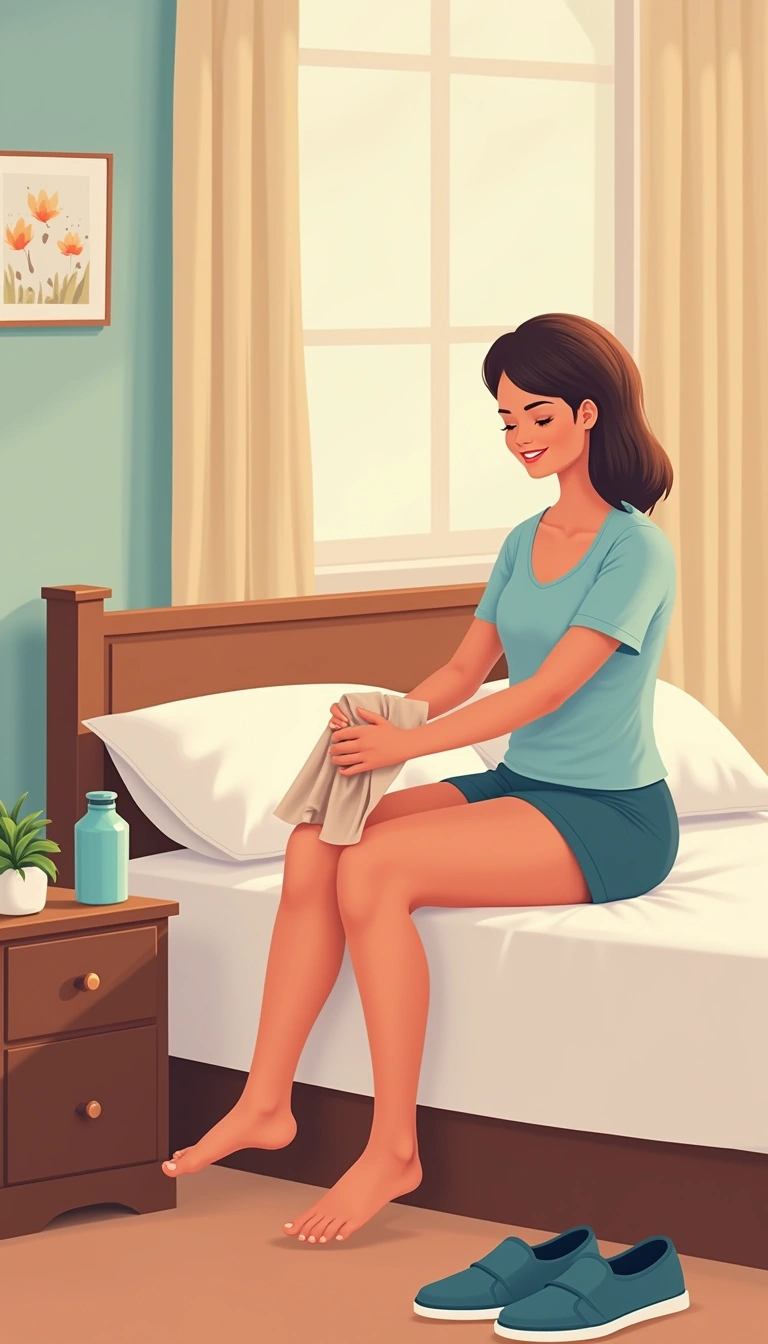Managing plantar fasciitis naturally can bring relief to your aching heels and restore your daily comfort. This painful foot condition affects millions of people every day. Simple self-care strategies can make a real difference in your healing journey. Let’s explore proven methods that work without expensive treatments or medications.
1. Stretch Your Feet First Thing in the Morning

Your plantar fascia tightens overnight, making those first steps incredibly painful. Morning stretches prepare your foot tissues for the day ahead and reduce that sharp heel pain.
Before getting out of bed, flex your foot and pull your toes toward your shin for 30 seconds. Repeat this simple movement three times on each foot. Many people notice immediate relief after just one week of consistent morning stretches.
Take Charge of Your Health with The Home Doctor
Discover real-world remedies and first-aid solutions you can use when help isn’t around.
👉 Claim Your Home Doctor GuideTip: Keep a towel by your bed to loop around your foot for a deeper stretch.
2. Roll Your Foot Over a Frozen Water Bottle
Ice therapy reduces inflammation in your plantar fascia while providing a gentle massage. The cold temperature numbs pain signals and helps control swelling in the affected tissue.
Freeze a standard water bottle and roll your bare foot over it for 10-15 minutes twice daily. Apply gentle pressure as you move your foot back and forth. The bottle’s shape perfectly contours to your arch and heel area.
Tip: Wrap the frozen bottle in a thin towel if the cold feels too intense on your skin.
3. Wear Supportive Shoes All Day Long
Proper footwear supports your arch and reduces strain on your plantar fascia. Shoes with good cushioning and arch support distribute your weight evenly across your foot.
Look for shoes with firm heel counters and adequate arch support. Athletic shoes designed for walking or running often provide the best support for plantar fasciitis. Avoid flip-flops, high heels, and completely flat shoes that offer no arch support.
Tip: Replace your shoes every 300-500 miles of walking or every 6-8 months for daily wear.
4. Use Night Splints While You Sleep
Night splints keep your foot in a flexed position while you sleep. This gentle stretch prevents your plantar fascia from tightening overnight and reduces morning pain significantly.
A night splint holds your foot at a 90-degree angle to your leg throughout the night. Most people experience less morning heel pain within 2-3 weeks of consistent use. You can find affordable night splints at most pharmacies or online retailers.
Tip: Start wearing the night splint for just a few hours initially to let your foot adjust gradually.
5. Massage Your Feet with a Tennis Ball
Self-massage improves blood flow to your plantar fascia and releases tension in tight foot muscles. Regular massage helps break up scar tissue and promotes healing in the affected area.
Sit in a chair and roll a tennis ball under your foot for 5-10 minutes daily. Apply firm pressure as you move the ball from your heel to your toes. Focus extra attention on any particularly tender spots you discover.
Tip: Use a lacrosse ball instead of a tennis ball for deeper pressure and more effective massage.
6. Strengthen Your Calf Muscles Daily
Strong calf muscles support your entire lower leg and reduce stress on your plantar fascia. Weak calves force your foot to work harder during walking and standing activities.
Perform calf raises by standing on your toes for 3 seconds, then slowly lowering down. Complete 15-20 repetitions twice daily. You can do these exercises anywhere – at your kitchen counter, office desk, or while watching television.
Tip: Progress to single-leg calf raises once the basic exercise becomes easy.
7. Apply Heat Before Activities
Warm therapy increases blood flow and makes your plantar fascia more flexible before exercise or long periods of standing. Heat helps prepare your foot tissues for increased activity levels.
Use a heating pad on low setting for 15-20 minutes before exercise or work. A warm foot bath works equally well for heating your entire foot. The increased circulation helps prevent re-injury during daily activities.
Tip: Never apply heat immediately after exercise – use ice instead to control post-activity inflammation.
8. Maintain a Healthy Weight
Extra body weight increases pressure on your plantar fascia with every step you take. Losing even 5-10 pounds can significantly reduce heel pain and speed up your recovery process.
Each pound of body weight creates about 4 pounds of pressure on your feet during walking. A 160-pound person puts approximately 640 pounds of force on their feet with each step. Reducing this load helps your plantar fascia heal more effectively.
Tip: Focus on low-impact exercises like swimming or cycling while your foot heals.
9. Choose Anti-Inflammatory Foods
Certain foods naturally reduce inflammation throughout your body, including your plantar fascia. A diet rich in anti-inflammatory nutrients supports your body’s healing processes from the inside out.
Include fatty fish like salmon, leafy greens, berries, and nuts in your daily meals. These foods contain omega-3 fatty acids and antioxidants that fight inflammation. Limit processed foods, sugar, and refined carbohydrates that can increase inflammation levels.
Tip: Add turmeric and ginger to your cooking for extra anti-inflammatory benefits.
10. Practice Towel Stretches
Towel stretches target your plantar fascia directly and improve flexibility in your entire foot. This simple exercise requires no special equipment and can be done anywhere you have floor space.
Sit with your legs extended and loop a towel around the ball of your foot. Gently pull the towel toward you while keeping your knee straight. Hold the stretch for 30 seconds and repeat 3 times on each foot.
Tip: Perform towel stretches both morning and evening for maximum benefit.
11. Avoid Walking Barefoot on Hard Surfaces
Hard surfaces like concrete, tile, and hardwood floors provide no cushioning for your heel strike. Walking barefoot on these surfaces increases impact forces on your already irritated plantar fascia.
Wear supportive slippers or shoes even inside your home. Look for indoor footwear with arch support and cushioned soles. Many people notice reduced pain within days of avoiding barefoot walking on hard floors.
Tip: Keep supportive slippers by your bed so you never have to walk barefoot on hard surfaces.
12. Take Regular Rest Breaks
Prolonged standing or walking aggravates plantar fasciitis symptoms and delays healing. Your inflamed tissues need periodic rest to recover from the constant stress of weight-bearing activities.
If your job requires long periods of standing, take 5-minute sitting breaks every hour when possible. Elevate your feet during lunch breaks to reduce swelling. Listen to your body and rest when heel pain increases during the day.
Tip: Use a footstool under your desk to elevate your feet while working at a computer.
13. Perform Alphabet Exercises
Alphabet exercises improve flexibility and strength in all the small muscles of your foot. These movements help maintain mobility while your plantar fascia heals from inflammation and micro-tears.
Sit comfortably and use your big toe to “write” each letter of the alphabet in the air. Complete the entire alphabet with each foot twice daily. This exercise improves circulation and maintains joint mobility throughout your foot and ankle.
Tip: Make the letters as large as possible to maximize the range of motion benefits.
14. Use Arch Support Inserts
Over-the-counter arch supports provide additional cushioning and proper foot alignment. Quality inserts redistribute pressure away from your heel and support your foot’s natural arch structure.
Look for inserts specifically designed for plantar fasciitis with firm arch support and heel cushioning. Replace generic shoe insoles with these therapeutic inserts in all your frequently worn shoes. Many people experience immediate pain relief with proper arch support.
Tip: Gradually increase wearing time with new inserts to allow your feet to adjust comfortably.
15. Stay Consistent with Your Routine
Healing plantar fasciitis naturally requires patience and consistency with your self-care routine. Most people see significant improvement within 6-8 weeks of following a comprehensive treatment plan.
Create a daily schedule that includes stretching, strengthening, and pain management techniques. Track your progress in a journal to stay motivated during the healing process. Consistency with these natural methods often prevents the need for more invasive treatments.
Tip: Set phone reminders for your exercises and stretches until they become automatic habits.
With dedication to these natural self-care strategies, you can effectively manage plantar fasciitis pain and return to comfortable daily activities.

Lifebing is driven by an unrelenting passion for promoting health and well-being, our team is wholly committed to curating exceptional content and immersive experiences.
